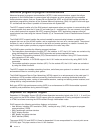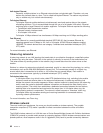
v Send
v Receive
At the primary end of the pipe is a Dependent LU Server (DLUS). At the secondary end of the pipe is a
Dependent LU Requester (DLUR). DLUS and DLUR support the activation and deactivation of dependent
physical units (PUs) and logical units (LUs) in the APPN network. The pipe consists of a pair of LU 6.2
conversations where two APPC applications (DLUR and DLUS) exchange dependent SNA SSCP flows.
The flows are encapsulated in a general data stream (GDS) variable and sent in LU 6.2 logical records.
The pair of conversations that are used to transmit encapsulated SNA is called the CP-SVR Pipe.
To configure DLUR, see the page Configuring Dependent LU Requester.
High-performance routing
High-Performance Routing (HPR) is the evolution of Advanced Peer-to-Peer Networking (APPN). HPR
enhances APPN data routing performance and reliability, especially when using higher-speed lower-error
links.
To support high-speed communications facilities, certain changes to the APPN architecture are required.
These are necessary to allow switching in intermediate nodes to be done at a lower layer and to enable
faster switching than in base APPN support. HPR changes the existing APPN intermediate session routing
by using automatic network routing (ANR), which maximizes the storage and processing requirement in
intermediate nodes. Each outbound packet has a predetermined path through the network so that
intermediate routing nodes need not remember anything about HPR sessions that flow through them.
Intermediate routing nodes in HPR simply route data that is based on information that is contained within
the packet itself.
The HPR function can operate under a base architecture, or can operate under the base architecture plus
options. There are performance capabilities available under the Tower RTP option not available with the
base. The page, HPR architecture option sets can give you a more thorough explanation of what
architecture option is right for you.
HPR architecture option sets
HPR-base option: Its primary function is to provide automatic network routing (ANR). Products that only
use this function can participate as intermediate nodes in one or more rapid-transport protocol (RTP)
connections. This type of implementation cannot be an end point of an RTP connection.
An addition to the base option is HPR Link-Level Error Recovery. A system that supports high-speed links
does not always require link-level error recovery. It is optional because when link-level error recovery is
eliminated there can be faster communications when using high-quality data transmission.
RTP Tower Option: Implementations that support this option can act as an endpoint and are able to
transport logical unit (LU) to LU session traffic across HPR networks by using RTP connections. An RTP
connection can only be made between two systems that support RTP. That is, there can only be a mix of
systems in a given RTP connection’s path through the network (ones that only support the HPR base
option and ones that support the HPR tower option). However, there is the stipulation that at least the two
end points in the path support the HPR tower option. Otherwise, APPN is used.
Note: An implementation that has the RTP Tower Option also supports the base option. These systems
can run as intermediate systems in the path.
Internetwork packet exchange support
If your group or business has an established Novell LAN, you can connect AS/400 into your business
using the OS/400 Internetwork Packet Exchange (IPX).
Chapter 9. Networking concepts 89


















